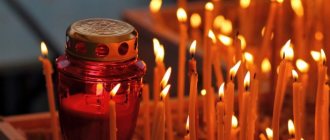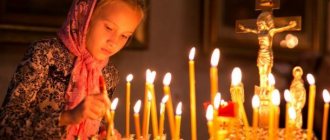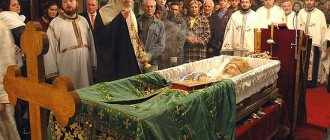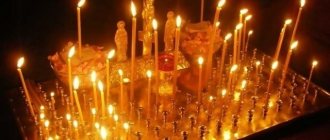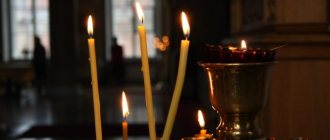"Save me, God!".
Thank you for visiting our website, before you start studying the information, please subscribe to our Orthodox community on Instagram, Lord, Save and Preserve † - https://www.instagram.com/spasi.gospodi/. The community has more than 60,000 subscribers. There are many of us like-minded people and we are growing quickly, we post prayers, sayings of saints, prayer requests, and timely post useful information about holidays and Orthodox events... Subscribe. Guardian Angel to you!
According to the Gospel, the church is like the body of Christ, like the unity of all the dead and living in God. She was given the right, in the name of the Lord and by his grace, to pray for the departed and make a bloodless sacrifice for them (prosphora at the liturgy). She can accompany the deceased on his last journey with a special rite of prayer - litia, funeral rites (panikhida) or evening repose (parastases).
What is a funeral service
The funeral service for the deceased in a church or in a ritual hall at a morgue is one of the important rituals, a burial rite that sends farewell to the departed soul to another world.
The rites include:
- poetry;
- canons;
- reading the Apostle and the Gospel.
Relatives, relatives, friends and acquaintances of the deceased present at the funeral service, together with the priest, should pray and ask the Almighty for help to the soul of the deceased.
About the funeral:
- Test of the soul after death
- How to cope with the death of a loved one
- Where to put the cross of a deceased person
Important! The funeral service is not a rite of forgiveness of sins. A prayerful funeral petition frees the soul of the deceased from those sins for which repentance was made during life, which the person could not remember in confession, or those that he did not consider to be a sin.
Relatives of the deceased need to read the Psalter until the 40th day
There is no funeral service for them
Persons who have committed an act of suicide, according to church canons, cannot be buried in church. But if the relatives of the suicide can show the clergy evidence that he has a mental disorder, and the diocesan administration gives them a special permit, then the priest will be able to conduct the funeral service. People who take their own lives through carelessness (unintentional poisoning, falling, drowning), as well as those who take a sinful step in a state of alcoholic intoxication and an acute psychopathic attack, are not recognized as suicides. At the same time, people who died from wounds received during a robbery are deprived of the church rite “Following Deadly”, since these criminals are classified as suicides. And women who died during childbirth or in the first forty days after them, contrary to established opinion, can be buried in the temple in compliance with all the rules.
Funeral service rules
After a person has died, relatives or people familiar with the deceased must read a prayer for the exodus of the soul, and read the Psalter until the 40th day (preferably 3 times from beginning to end).
Advice! You can purchase a prayer book with prayers for repose and the Psalter at any church store, although a Christian should have these books in stock.
According to Orthodox custom, the funeral service takes place on the third day from the moment of death.
This is due to the fact that from days 1 to 3 the soul is on earth, near its home, with loved ones, or traveling around the world, and then ascends to worship the Creator. From days 3 to 9, the newly departed soul is shown the heavenly abodes by angels, and then, from days 10 to 40, she contemplates hell.
On the 40th day, the soul appears before the Throne of the Lord and on this day its fate until the Last Judgment is decided: whether it will await it in heaven or hell.
Important! The intense prayer of the Church and the relatives of the deceased play a very important role and help the soul enter the Kingdom of Heaven.
According to tradition, at the end of the funeral service, the coffin with the deceased is accompanied to the cemetery by the relatives of the deceased, led by a priest.
Previously, the procession stopped at every intersection along the route to read funeral prayers. Now the cleric anywhere asks mourners to pray for the soul of the deceased. The number of such stops is not regulated.
Funeral service in church
In Orthodoxy, it is customary to perform the funeral service for the deceased in church.
To complete it you need:
- know the will of the deceased (often people on their deathbed ask that their soul be sung by a certain priest in a specific church);
- be sure that the deceased was baptized in the Orthodox faith;
- obtain a death certificate from the civil registry office;
- prepare a death certificate (with signatures and seals);
- come to the chosen church and present the necessary documents certifying the fact of death, agree on the date, time and place of the funeral service;
- purchase in the church shop the necessary attributes for the deceased: a body cross, a cross in the hands, candles for the coffin, a blanket, a small pillow, a shroud, a whisk, a form with a prayer of permission;
- for people saying goodbye to the deceased, buy a sufficient number of candles;
- make a donation for the Sacrament.
Attention!
The land with which the priest sprinkles a cross on the body of the deceased is not bought - it is given out in the church. It is necessary to correctly calculate the time for which the funeral meal will be scheduled (the funeral service lasts on average 40 minutes).
In Orthodoxy, it is customary to perform the funeral service for the deceased in church.
Carrying out the ritual
Usually the body is brought from the morgue to the temple fully prepared:
- there is a crown on the forehead of the deceased;
- there is a cross in his hand and on his chest;
- the body is covered with a shroud.
The required cleric places candles on the coffin and lights them, and relatives distribute candles to those accompanying the deceased on his last journey (lit candles in their hands symbolize the victory of life over death).
The coffin is placed facing the altar and the priest begins to read prayers, psalms, and Holy Scripture. Thus, he and those present, praying together with the cleric, beg the Almighty to forgive the deceased all his sins and grant the Kingdom of Heaven. The stronger the conciliar prayer, the greater the “chance” for the soul to unimpededly pass through the airy ordeals and ascend to the abode of heaven.
After reading the prayer of permission, a piece of paper with its text is placed in the hand of the deceased and the last opportunity comes to say goodbye to the deceased. To do this, you need to kiss the icon on the chest and the aureole on the forehead of the deceased. In these intimate and reverent seconds, you can ask for forgiveness from the deceased, whisper his last words.
If the funeral service is performed with the coffin closed, then when saying goodbye you should venerate the cross on its lid. Then the priest covers the deceased with a shroud and sprinkles him with consecrated earth in the shape of a cross.
Important! The icon lying on the chest of the deceased should be taken home, placed on the iconostasis and prayed in front of it.
The Church never sets tariffs for services. The price tags indicate only the estimated donation amounts - the amount that a person is willing to donate (this is determined by the financial capabilities of the donor himself).
Prayers for the deceased:
- Prayer to the Mother of God for the newly departed deceased
- Canon on the separation of the soul from the body
- Following the departure of the soul from the body
Funeral signs and beliefs
Funeral rituals invariably attract spirits, so it is extremely important to know the signs and follow the rules. Otherwise, you can easily bring damage to yourself and your loved ones. The most accurate funeral signs, tested by many generations of our ancestors, are described below.
- During the funeral, stand so that you do not have the potential to make eye contact with the deceased. If the eyes are opened, then the one the dead person “looks” at will die next.
- If you are afraid of a dead person, hold his legs and the fear will disappear.
- You can make a strong amulet if you place a consecrated willow under the deceased for several hours.
- You cannot cross the path of a funeral procession - this is fraught with terrible diseases.
- At a funeral, you can heal from tumors: squeeze the right hand of the deceased and make circular movements with it over the problem area. Read the Lord's Prayer three times, spitting to the left after each reading.
- If the deceased was buried with other people's personal belongings, then great grief awaits their owner.
- Burying a photo of a living person with a deceased person is a sign of his terminal illness.
- A pregnant woman attending a funeral will give birth to a sick child.
- Touching yourself when you see a dead person means the development of a tumor at the site of contact.
- Stepping on a ritual towel lying near the coffin means illness.
- Eating or drinking a treat left for the deceased means physical weakening.
- If one of the neighbors along your street has died, do not sow or plant until the funeral, otherwise the year will be a bad harvest.
- After a neighbor's death, drinking water in bottles and carafes should be renewed so as not to get sick.
- If the deceased is not buried for more than 7 days, one of his relatives will die.
- If you don’t celebrate your forties, your soul will not find peace.
- The water remaining after ablution should not be spilled in a residential building - its inhabitants may die.
- You cannot sleep if there is a funeral procession nearby - there is a risk of death.
- You can kill any bird by feeding it wheat into which a funeral candle was stuck.
- You cannot touch thresholds and doorposts when taking out the coffin - the soul of the deceased may return to the house with bad intentions.
- If the feet of the deceased are warm to the touch, it means that he is calling someone from those present to the next world.
Existing bans
A loved one who has passed into another world must be mourned in a Christian way
Funeral services are not performed in the Orthodox Church for:
- unbaptized (for such deceased people should be prayed privately);
- Gentiles;
- God-fighters;
- those who have renounced Christ;
- suicides (the exception is taking one’s own life while in a state of insanity, but this must be proven and permission to perform a funeral service obtained from the ruling bishop);
- infants who have not been worthy of Holy Baptism (they have not been cleansed by the Holy Spirit from the sin of their ancestors);
- stillborn or babies killed in the womb.
What and how many flowers are placed on the grave
The number of flowers brought to the funeral is always even - 2,4,8,12. Usually these are carnations, roses of different shades, chrysanthemums and even lilies. In addition to flowers, wreaths are also placed; they are made from spruce or pine branches intertwined with mourning ribbons and flowers. Large or lavish bouquets are not needed at a funeral. It is better if the flowers are simple, not pretentious. If a large bouquet is placed, it is usually brought by a relative of the deceased. Such attentions from acquaintances are not welcome. The standard two roses or carnations entwined with a mourning ribbon are quite enough.
The Church does not approve of the presence of many wreaths and bouquets on the grave. The dead no longer need them, and the living pay tribute to pagan rituals with such an offering.
Funeral service in absentia
A sacrament is rarely performed without the presence of the body of the deceased. This is possible in the following cases:
- when the deceased was buried many years ago, but for some reason there was no funeral service;
- if a person died in war, as a result of a terrorist attack, a plane crash, drowned in a shipwreck, or went missing.
The priest sanctifies and blesses the specially prepared soil and reads a prayer. At the end of the funeral service, the land plot is given to the relatives of the deceased. It is necessary to sprinkle the grave crosswise.
If the deceased was cremated, then the earth should be poured into the urn with the ashes.
Advice! If the burial place is unknown or is far away, and there is no way to get to it, then there is no need to take the land from the church.
How to dress for a funeral
Many people do not know how to dress and what not to do at a funeral so as not to cause condemnation and to look decent. Not everyone has black mourning clothes; burial is not an ordinary event. If you don’t have a black dress or suit, then the main thing is to follow the unwritten, but familiar to every business etiquette:
- dresses that are too short are not appropriate, the skirt should cover the knees and even go lower;
- they do not appear in clothes with bright patterns, embroidery, or rhinestones at funerals, even if they are talking about a child;
- clothes with a deep neckline and bare shoulders are left at home.
A woman should wear a simple dress or skirt and blouse in shades of blue, brown or gray. It can be a trouser suit, but if the farewell ceremony is held in a church, then a skirt is required. High heels are replaced with pumps or ballet flats. It is indecent to wear sneakers to a cemetery. Orthodox women tie a scarf around their heads. In the West, they wear a small hat with a black veil.
Men can come in a suit or black trousers and a dark shirt. Jewelry is not worn at a funeral; only the simplest jewelry is allowed - earrings in the ears and a wedding ring on the finger.
Example of mourning clothing

